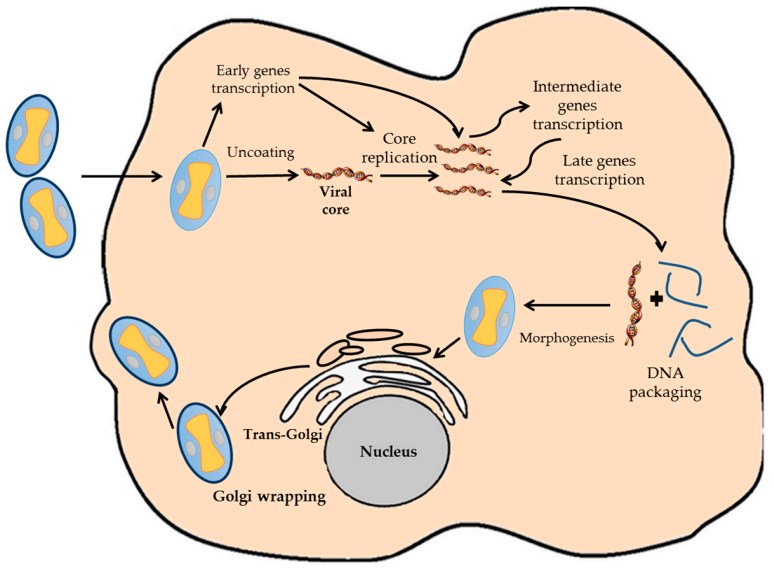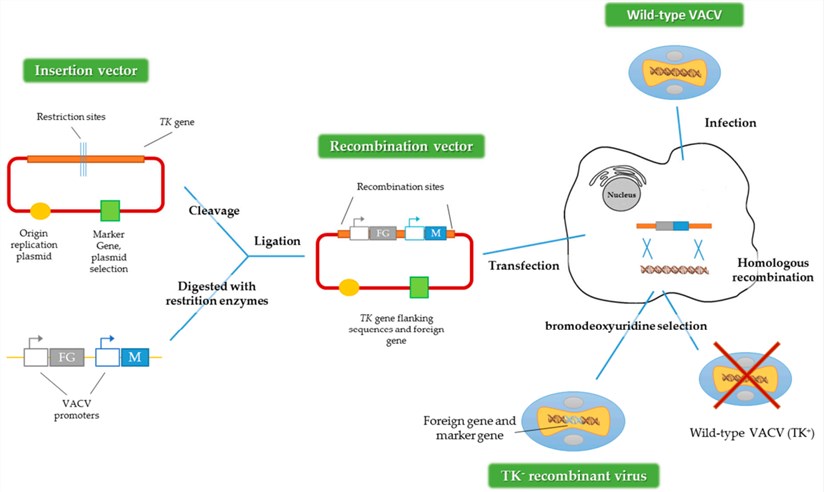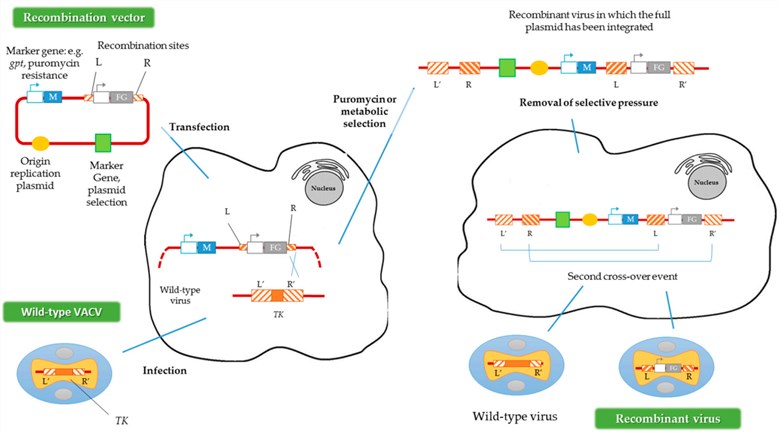Vectors Based on the Vaccinia Virus
Biology of Vaccinia Virus (VACV)
Vaccinia virus (VACV) is a large, complex, enveloped virus that belongs to the poxvirus family. It has a linear, double-stranded DNA genome of approximately 190 kb in length, which encodes for around 250 genes. The genome is surrounded by a lipoprotein core membrane and has high genetic compaction, with a few intergenic and small non-coding regions. VACV has a complete replicating cycle in the cytoplasm of the host cell (Figure 1), which determines the genetic characteristics of the virus, being completely independent of the replication and transcription machinery of the host cell.
 Figure 1. A graph representing the VACV infection cycle. (Al Ali, 2016)
Figure 1. A graph representing the VACV infection cycle. (Al Ali, 2016)
VACV as A Vector
Several biological features of VACV make it suitable for use as a viral vector in vaccine design or cancer therapy. VACV can hold up to 25 kb of foreign DNA, making it useful for expressing large genes. Foreign genes are integrated stably into the viral genome, resulting in efficient gene expression. VACV re-engineered to express foreign genes is considered as a powerful vector for the production of recombinant proteins. They have been engineered to express immunizing antigens of the herpes virus, influenza, hepatitis B, rabies, human immunodeficiency virus (HIV), and other viruses. At present, some highly attenuated, host-restricted, non-replicating or poorly replicating poxvirus strains have been developed for use as substrates in the development of recombinant vaccines. These strains include Modified Vaccinia Ankara (MVA) and NYVAC, ALVAC and TROVAC.
- MVA
- NYVAC
- ALVAC
- TROVAC
The MVA virus is a highly attenuated vaccinia virus strain, which is derived from Vaccinia strain Ankara by over 570 passages in chicken embryo fibroblast cells (CEF). MVA has high safety, so it is widely regarded as the preferred vaccinia virus strain for clinical research. Compared to replicating VACV, MVA offers similar or higher levels of recombinant gene expression even in non-permissive cells. In animal models, it has been found that the recombinant MVA vaccine is immunogenic and can protect against various infectious agents including parainfluenza, influenza, flaviviruses, measles virus, and plasmodium parasites. The combination of good safety and the ability to deliver antigens in a highly immunogenic manner makes MVA suitable for use as a vaccine carrier.
The attenuated NYVAC vector is derived from a plaque-cloned isolate of the Copenhagen vaccinia vaccine strain by deleting 18 open reading frames (ORFs) from the viral genome. The vector retains the ability to express foreign genes and generate an immune response in the immunized host. Because two C7L and K1L host-range genes were deleted at the same time, NYVAC could not replicate in human cells. Like MVA, NYVAC is being extensively studied in clinical vaccination trials for many infectious diseases, including HIV.
ALVAC is an attenuated canarypox virus vector that was a plaque-cloned derivative of Kanapox, a licensed canarypox vaccine. ALVAC is a ubiquitous vector with high biosafety and replicates only in avian species, which provides an important safety barrier for human use. The canarypox virus vector has been used to develop several vaccines for animals and humans. A number of clinical trials in humans are ongoing such as ALVAC HIV-1 vaccines.
TROVAC refers to an attenuated fowlpox that was a plaque-cloned isolate derived from the FP-1 vaccine strain of fowlpox virus, which is licensed for vaccination of one-day-old chicks. Like ALVAC, these viruses do not grow in mammalian cells and, therefore, do not produce clinical infections among humans.
Generation of VACV Vectors
- To obtain recombinant VACV expressing foreign genes, the main method used is homologous recombination (Figure 2). First, a plasmid containing the target gene needs to be constructed. After that, the cells must be infected by the virus and then transfected with the plasmid containing the target gene. An alternative method could be used, employing two viruses, one defective for some genes and one wild-type acting as a helper. For both methods, the recombinant viruses are produced by homologous recombination within the infected cell.
 Figure 2. Construction of recombinant VACV vectors by homologous recombination. FG: foreign gene, M: marker gene, TK: thymidine kinase gene. (Al Ali, 2016)
Figure 2. Construction of recombinant VACV vectors by homologous recombination. FG: foreign gene, M: marker gene, TK: thymidine kinase gene. (Al Ali, 2016)
- Another way to produce recombinant viruses is the Transient Dominant Selection (TDS) method described by Falkner and Moss named, which allows the introduction of site-directed mutations into the VACV genome. Generally, the recombinant viruses obtained by this method are rescued by the metabolic selection, using the guanine phosphoribosyltransferase gene (gpt) from E. coli as a marker. The presence of the protein encoded by gpt allows the recombinant viruses to grow in the presence of mycophenolic acid, xanthine and hypoxanthine. Subsequently, after this first metabolic selection, a second recombination event must occur to eliminate the selection marker, maintaining the mutation introduced into the VACV genome (Figure 3).
 Figure 3. Construction of recombinant VACV vectors by TDS method. FG: foreign gene, M: marker gene, R and L: the right and left flanking regions of the TK gene in the plasmid, R' and L': the same regions of the TK gene in the VACV genome. (Al Ali, 2016)
Figure 3. Construction of recombinant VACV vectors by TDS method. FG: foreign gene, M: marker gene, R and L: the right and left flanking regions of the TK gene in the plasmid, R' and L': the same regions of the TK gene in the VACV genome. (Al Ali, 2016)
Reference
- Al Ali, S.; et al. (2016). Use of reporter genes in the generation of vaccinia virus-derived vectors. Viruses. 8(5): 134. Distributed under Open Access license CC BY 4.0, without modification.
